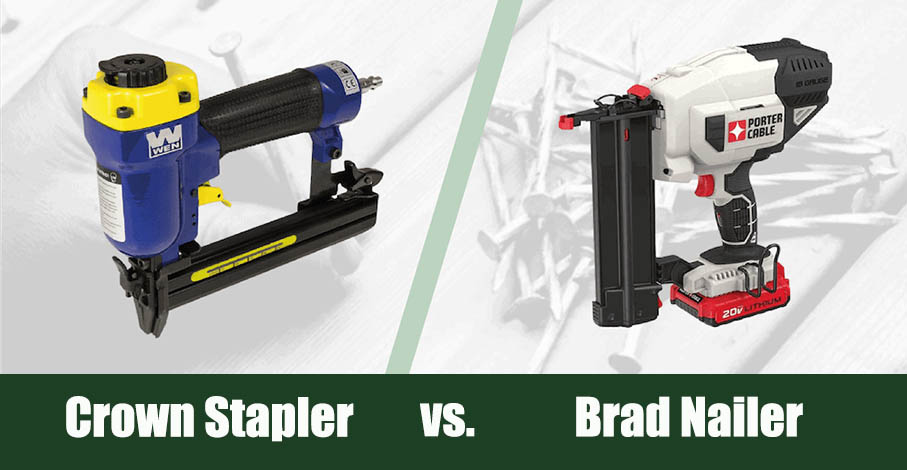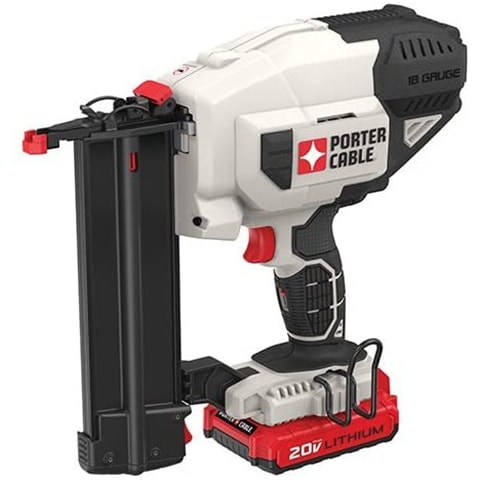Crown Stapler vs Brad Nailer – Which is Best for Your Project?
-
- Last updated:


Crown staplers and brad nailers are similar tools with distinct applications. They are both power tools used for fastening things together, but their ideal uses can differ greatly. The biggest differences are holding power and hole size, which dictate where best to use each tool.

Crown Stapler Overview
Crown staplers, as the name might suggest, use staples to fasten things together. The “crown” refers to the top part of the staple between the two longer legs, which penetrate the material to be joined together. Crown staples come in various sizes, both in terms of gauge (thickness) of the staple, and the width of the crown.
Commonly, crown widths are referred to as narrow, medium, and wide. The width of the staple crown combined with the length and width of the legs to establish holding power. The larger, the heavier duty the staple.

Applications
Staples can be used in a variety of applications, but they leave large holes behind due to the crown of the staple. As a result, they’re best used in places where the appearance either doesn’t matter, or the hole will be hidden.
Narrow Crowns
Narrow crown staples are best used for trim, fabric, and light framing jobs. The advantage of using staples for trim is that they don’t necessarily need to be used in conjunction with adhesive in order to have good holding power. The disadvantage is the hole, so if you use a narrow crown stapler to apply trim, you’ll need to go back over it with putty or another filler.
Narrow crown staples can also be used for fabric. If you have an upholstery job, and don’t have a fabric stapler, narrow crowns can be used in a pinch. It’s important to note that, due to the narrow crown, the fabric can rip and tear around the point of penetration, and so may not offer a hold that’s as effective as that provided by an upholstery stapler.
Light framing jobs, using ¾-inch material or smaller, are a great application for narrow crown staples. They offer good hold and won’t damage the framing material as much as a larger staple. In order to cement the hold, adhesive should be used in this application.
Medium Crowns
Medium crown staples offer greater hold, but do more damage to the surface of the material on entry, due to their greater size. They can be used for a range of applications, including subflooring, siding, and plywood sheathing. The great thing about using them for siding is that it typically overlaps, so the holes will be covered with the next piece of siding you apply.
Wide Crowns
Wide crown staples should be reserved for the heaviest duty uses. This includes construction applications like house wrap, truss building, and roofing. Most applications will conceal the penetration point and as a result, the hole from the crown of the staple will not be noticeable.
- Variety of sizes for different applications
- Good for heavy-duty jobs
- Not aesthetically pleasing

Brad Nailers Overview
Brad nailers make use of straight fasteners called brads. They come in multiple gauges and lengths. The gauge of the brad is the primary influence on its holding power. So, a thinner brad won’t hold as well as a wider one. The length of the brad is important because it determines the material it will go through. A good rule of thumb with brads (or any fastener) is that the fastener should be twice the length of the material it’s going through in order to make it hold fast.

Applications
Brads have a variety of applications, none of them heavy duty. Their primary function is to fasten materials together with minimal damage to the face of the materials. This limits the amount of patching that needs to be done when utilizing brads for finish work.
Finish work is the name of the game for brad nailers. They’re the ideal tool for trim, fascia, and paneling. Because they don’t cause a lot of damage on the surface of the wood, they make for a cleaner finish in any of these applications.
Holding Power
When using a brad nailer for fastening, there are a couple of important caveats that should be taken into account. First, brads don’t have the holding power of staples or even finish nails. As a result, adhesive should be used in most applications in order to reinforce the hold of the fasteners.
Second, they don’t have a great deal of sheer strength. So, they should never be used in weight bearing applications. There are larger nailers that are intended for these applications, and they should be explored as options where structural integrity is of utmost importance.
- Leave a clean finish
- Good for light-duty work
- Not as strong as crown staples
When to Use Which?
Brad nailers and crown staplers have some overlap in that they’re both used for fastening materials together. In fact, both narrow crown staples and brads can be used for similar trim applications although in most cases a brad nailer is the better selection for trim. However, there are critical differences between the two that need to be considered when choosing the right tool for the job.
First, define the level of structural integrity required for the job. If there’s a lot of force being placed on a joint, brads are not going to be the best selection. Neither are narrow crown staples, for that matter. In cases like these, heavier duty staples or even other fastener options completely are a better choice.
Second, it’s important to keep in mind how much holding power is required for the job at hand. Staples generally have better hold than brads. So, if holding power is a critical element of the job, crown staplers are a better choice.
Finally, the level of finish required should be examined. For jobs that don’t require a high touch finish, there’s no reason to use a brad nailer. Opt for one of the crown stapler options instead.

Conclusion
After taking these elements under consideration, it should be easy to make the decision about which tool to use: crown stapler or brad nailer.
Related Reads:
- WORX GT2 VS WORX GT3 – WHICH ONE’S BEST?
- CORDLESS VS CORDED DREMEL: WHICH IS BEST FOR YOU?
- PIN NAILER VS BRAD NAILER: WHICH IS BEST FOR YOUR NEEDS?
- Brad Nailer vs Finish Nailer: Which is Best for Your Needs?
Featured Image: Carpetner, Shutterstock
Contents

